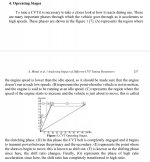bob58o
SuckSqueezeBangBlow
I understand , on paper it does not make sense
That's the kind of data I was hoping for. Both setups should give 5.4 :1 when fully shifted. The results don't really surprise me, but until I understand WHY, this is still going to bug me.
The only thing that is different, that I can think of is how high the belt rides between the driver sheaves. If the sheaves cannot close all the way, the belt must ride lower. But it doesn't seem like the belt is slipping when all the way at the top - because the engine didn't rev. If it was slipping the engine would still rev higher, but the MPHs wouldn't come along.
And if the driver doesn't close all the way, the driven probably doesn't open all the way - so the belt probably doesn't ride as low in the driven.
I don't get it. Is more power being lost to heat (without the shim)?





